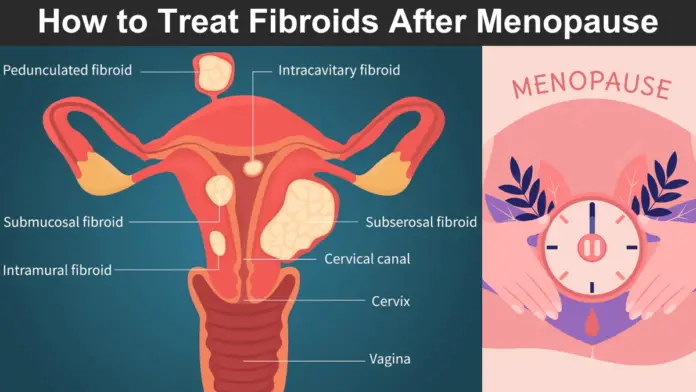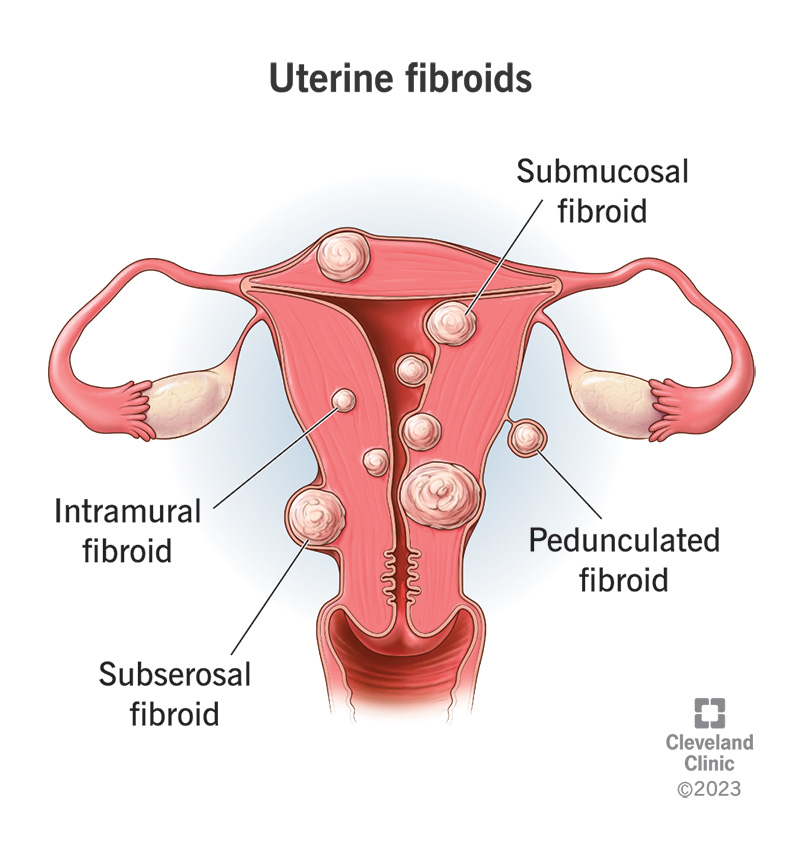
Fibroids, non-cancerous growths that develop in or around the uterus, are a common health concern among women, with studies indicating that upwards of 70% of women will develop fibroids at some point in their lives. Although fibroids often shrink and cause fewer symptoms after menopause due to a decrease in hormone production, some women still experience discomfort and other health issues attributable to fibroids. Furthermore, in rare cases, fibroids can continue to grow even after menopause. This underscores the need for effective management strategies for fibroids post-menopause. In this comprehensive guide, we delve into the subject of how to treat fibroids after menopause, offering insights based on the latest research and expert opinion.
Understanding Fibroids

Fibroids, medically referred to as uterine leiomyomas, are non-cancerous growths that develop in the muscular wall of the uterus. They vary significantly in size, ranging from tiny growths that are almost undetectable to the human eye to large masses that can alter the shape and size of the uterus. Some fibroids may be solitary, while others may occur in clusters.
The Formation of Fibroids
Fibroids are thought to form when a single muscle cell in the uterus goes through an abnormal replication process. This results in a fibrous “knot” of smooth muscle cells and fibrous connective tissue. The exact cause of this abnormal cell replication is not entirely understood, but research points to both genetic and hormonal factors as key contributors.
The Role of Hormones
Estrogen and progesterone, the two hormones that stimulate the development of the uterine lining during each menstrual cycle in preparation for pregnancy, seem to promote the growth of fibroids. Fibroids contain more estrogen and progesterone receptors than normal uterine muscle cells, making them more susceptible to these hormones. This is why fibroids tend to shrink after menopause when hormone production decreases.
Types of Fibroids
Fibroids are classified according to their location in the uterus. These include:
- Intramural fibroids: These are the most common type of fibroids, growing within the muscular wall of the uterus.
- Subserosal fibroids: These fibroids grow on the outside of the uterus.
- Submucosal fibroids: These are less common, and grow just underneath the uterine lining and can protrude into the uterine cavity.
Understanding the nature and behavior of fibroids is the first step towards managing them effectively, especially after menopause when the dynamics of their growth can change. The next section will explore ways to treat fibroids after menopause.
Fibroids After Menopause: Why They Still Matter
You might assume that with the onset of menopause and the subsequent decline in hormone production, fibroids should cease to be an issue. However, this isn’t always the case. While it’s true that fibroids generally shrink after menopause due to decreased levels of estrogen and progesterone, they don’t disappear entirely.
Even after menopause, fibroids can continue to cause symptoms such as pelvic pain, urinary frequency, and constipation. In some cases, fibroids might even grow in size. This could be due to the body’s use of stored estrogen found in fat cells, especially in women with a higher body mass index (BMI). Additionally, certain hormone therapies used to manage menopausal symptoms might also contribute to the size and behavior of fibroids post-menopause.
The changes in hormonal levels during menopause can make the management of fibroids a complex task, requiring a nuanced understanding of the patient’s overall health status, medical history, and symptoms. It’s crucial to seek medical advice and regularly monitor fibroid growth and symptoms, even after menopause. The following sections will delve into the various options available on how to treat fibroids after menopause.
How to Treat Fibroids After Menopause
1. Hormone Therapy
Hormone therapy is a common treatment method for menopausal symptoms and it can also have an impact on fibroid treatment. However, for women with fibroids, hormone therapy needs to be carefully managed. Estrogen and progesterone, hormones that are commonly used in therapy, can cause fibroids to grow. The key is to balance hormone levels to minimize menopausal symptoms while not exacerbating fibroid growth.
2. Non-Invasive Procedures
Non-invasive procedures are a viable option for treating fibroids after menopause. These include:
- Uterine Artery Embolization (UAE): This procedure involves blocking the blood supply to the fibroid, causing it to shrink.
- MRI-Guided Focused Ultrasound Surgery (MRgFUS): This is a non-invasive treatment that uses high-intensity ultrasound waves to heat and destroy the fibroid tissue.
- Radiofrequency Ablation (RFA): This involves the use of radiofrequency energy to destroy fibroid cells.
These procedures are typically outpatient, meaning they don’t require a hospital stay, and recovery time is usually quick.
3. Surgery
In some cases, surgery may be necessary to treat fibroids after menopause. Surgical options include:
- Myomectomy: This surgery removes fibroids while leaving the uterus intact. It is a good option for women who wish to preserve their fertility.
- Hysterectomy: This is a more drastic option that involves removing the entire uterus. It’s generally reserved for women with large fibroids or severe symptoms.
Each surgical option has its pros and cons, and the choice largely depends on individual circumstances such as the size and location of the fibroids, the woman’s age and health status. Always consult with your healthcare provider to determine the best course of treatment for you.
Lifestyle Adjustments
1. Dietary Changes
A balanced, nutrient-rich diet can play a supportive role in managing fibroids after menopause. Here are some dietary adjustments that may help:
- Increase Intake of Green Vegetables: Leafy greens like spinach, kale, and broccoli are rich in antioxidants and fiber, which can support overall health and help in managing fibroids.
- Limit Red Meat and Processed Foods: Studies suggest a link between consumption of red meat and processed foods and the prevalence of fibroids. Opt for lean proteins such as chicken, fish, and legumes instead.
- Add Flaxseeds to Your Diet: Flaxseeds are rich in fiber and omega-3 fatty acids, which can help in reducing inflammation and potentially the size of fibroids.
2. Regular Exercise
Engaging in regular physical activity is another effective way to manage fibroids after menopause. Exercise can help:
- Reduce Inflammation: Regular exercise reduces the levels of inflammation in the body, which can help in managing fibroids.
- Maintain a Healthy Weight: Maintaining a healthy weight can reduce the risk of fibroids and can also alleviate symptoms in women who already have fibroids.
- Enhance Overall Well-being: Apart from the direct benefits related to fibroids, exercise can enhance overall physical and mental health.
It’s recommended to aim for at least 30 minutes of moderate exercise most days of the week. This could include activities like walking, cycling, swimming, or yoga.
3. Stress Management Techniques for Fibroids After Menopause
Stress management plays a crucial role in treating fibroids after menopause. Chronic stress can lead to hormonal imbalances and inflammation, which may potentially aggravate fibroids. Here are some effective stress management techniques that can be incorporated into your daily routine:
a. Mindfulness and Meditation:
Mindfulness involves bringing your attention to the present moment. Practicing mindfulness, particularly through meditation, can reduce stress levels and promote overall well-being. Some easy-to-implement mindfulness techniques include:
- Mindful Breathing: This involves focusing your attention on your breath, which can calm the mind and help you remain present.
- Body Scan Meditation: This involves mentally scanning your body for areas of tension, which can help you become more aware of the physical sensations within your body and release any stress.
b. Yoga and Tai Chi:
Both yoga and Tai Chi are forms of exercise that incorporate elements of mindfulness and deep breathing, which can be beneficial in reducing stress. Regular practice can help:
- Improve Flexibility: These practices can improve flexibility and strength, which can aid in relieving physical symptoms of stress.
- Enhance Mind-Body Connection: The mindful nature of these practices can enhance the connection between mind and body, promoting overall relaxation and stress reduction.
c. Healthy Sleep Habits:
Sleep plays a crucial role in stress management. Lack of adequate sleep can exacerbate stress and negatively impact overall health. Here are some tips to improve sleep quality:
- Maintain a Consistent Sleep Schedule: Go to bed and wake up at the same time each day, even on weekends, to regulate your body’s internal clock.
- Create a Restful Environment: Keep your bedroom dark, quiet, and cool, and invest in a comfortable mattress and pillows.
- Limit Exposure to Screens Before Bed: The light emitted by phones, tablets, computers, and televisions can interfere with your body’s ability to fall asleep.
Adopting these stress management techniques can help in managing fibroids after menopause. However, it’s always recommended to reach out to a healthcare professional for personalized advice and treatment options.
Regular Check-ups: An Essential Step in Treating Fibroids Post-Menopause
Regular medical check-ups play a crucial role in the overall management and treatment of fibroids after menopause. They provide an opportunity for healthcare professionals to monitor the progress of your condition, adjust your treatment plan as necessary, and address any concerns or symptoms you may be experiencing.
Monitoring the Size and Symptoms of Fibroids
Fibroids may shrink naturally after menopause due to the decrease in estrogen levels. Regular check-ups allow doctors to track the size of the fibroids and monitor any symptoms. This is typically done through pelvic examinations and imaging tests, such as ultrasounds or MRI scans.
Adjusting Treatment Plans
Post-menopausal women with fibroids may experience changes in their symptoms over time. Regular check-ups allow doctors to adjust treatment plans as needed, whether it involves medication changes or the consideration of surgical options.
Discussing Concerns and Symptoms
Regular check-ups present an opportunity for you to share any concerns or new symptoms with your doctor. This open communication is key in managing fibroids after menopause.
Remember, though fibroids tend to shrink after menopause, it’s not always the case. Hence, maintaining regular check-ups is a proactive step in your health journey.
Frequently Asked Questions
Q: Can fibroids grow after menopause?
A: In most cases, fibroids tend to shrink in size after menopause due to the decrease in estrogen levels. However, there are instances, though rare, where fibroids can continue to grow even after menopause. It’s essential to maintain regular check-ups to monitor any changes in fibroids.
Q: Can you get new fibroids after menopause?
A: The occurrence of new fibroids after menopause is extremely rare. Most women won’t develop new fibroids once they reach menopause. However, existing fibroids may still be present and could cause symptoms, which necessitates regular monitoring.
Q: How are fibroids treated after menopause?
A: The treatment of fibroids after menopause is typically dependent on the symptoms. If no symptoms are present, no treatment might be necessary other than regular monitoring. If symptoms persist, treatment options can range from medication to manage symptoms, to surgical procedures if the fibroids are large or causing significant discomfort.
Q: Can fibroids cause post-menopausal bleeding?
A: Post-menopausal bleeding should always be evaluated by a healthcare professional. While fibroids are less likely to cause bleeding after menopause, they can occasionally be the cause. However, any post-menopausal bleeding needs immediate medical attention as it can also be a sign of other serious conditions, including uterine cancer.
Conclusion
In conclusion, learning how to treat fibroids after menopause is a critical part of a woman’s proactive health management. Even though fibroids tend to shrink or remain stable post-menopause, regular monitoring is still necessary to track any changes, especially as some fibroids can still cause discomfort and symptoms. It’s crucial to remember that treatments are available and can range from medications to surgical procedures, depending on the severity of the symptoms. The journey to managing fibroids after menopause may be challenging, but with the right knowledge and medical support, it is entirely feasible. Remember, your health is your wealth; take the necessary steps to ensure you are in control of your well-being.












